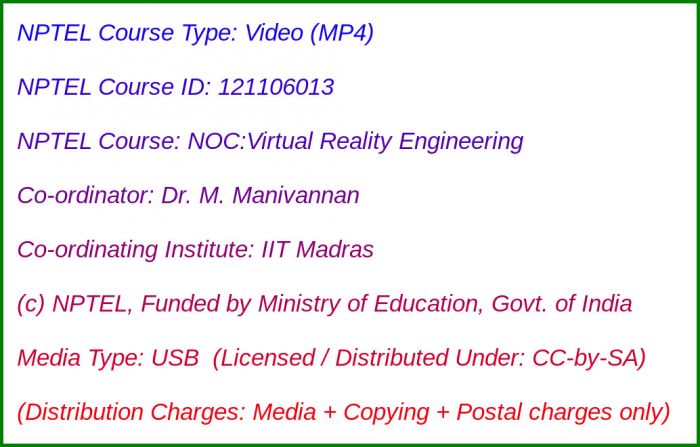
Media Storage Type : 64 GB USB Stick
NPTEL Subject Matter Expert : Dr. M. Manivannan
NPTEL Co-ordinating Institute : IIT Madras
NPTEL Lecture Count : 90
NPTEL Course Size : 35 GB
NPTEL PDF Text Transcription : Available and Included
NPTEL Subtitle Transcription : Available and Included (SRT)
Lecture Titles:
Lecture 1 - Course mechanics
Lecture 2 - Goals and VR definitions
Lecture 3 - Historical perspective
Lecture 4 - Birds-eye view (general)
Lecture 5 - Birds-eye view (general) (Continued...)
Lecture 6 - Birds-eye view (hardware)
Lecture 7 - Birds-eye view (software)
Lecture 8 - Birds-eye view (sensation and perception)
Lecture 9 - Geometric modeling
Lecture 10 - Transforming models
Lecture 11 - Matrix algebra and 2D rotations
Lecture 12 - 3D rotations and yaw, pitch, and roll
Lecture 13 - 3D rotations and yaw, pitch, and roll (Continued...)
Lecture 14 - Axis-angle representations
Lecture 15 - Quaternions
Lecture 16 - Converting and multiplying rotations
Lecture 17 - Converting and multiplying rotations (Continued...)
Lecture 18 - Homogeneous transforms
Lecture 19 - The chain of viewing transforms
Lecture 20 - Eye transforms
Lecture 21 - Eye transforms (Continued...)
Lecture 22 - Canonical view transform
Lecture 23 - Viewport transform
Lecture 24 - Viewport transform (Continued...)
Lecture 25 - Three interpretations of light
Lecture 26 - Refraction
Lecture 27 - Simple lenses
Lecture 28 - Diopters
Lecture 29 - Imaging properties of lenses
Lecture 30 - Lens aberrations
Lecture 31 - Optical system of eyes
Lecture 32 - Photoreceptors
Lecture 33 - Sufficient resolution for VR
Lecture 34 - Light intensity
Lecture 35 - Eye movements
Lecture 36 - Eye movements (Continued...)
Lecture 37 - Eye movement issues for VR
Lecture 38 - Neuroscience of vision
Lecture 39 - Three Psychophysical Laws
Lecture 40 - Sensation and Perception
Lecture 41 - Psychophysics of Visual Perception
Lecture 42 - Gamma Encoding
Lecture 43 - Limiting Resolution
Lecture 44 - Depth perception
Lecture 45 - Depth perception (Continued...)
Lecture 46 - Motion perception from Visual Systtem
Lecture 47 - Frame rates and displays
Lecture 48 - Frame rates and displays (Continued...)
Lecture 49 - Psyohophysics of Depth Perception
Lecture 50 - Overview
Lecture 51 - Orientation tracking
Lecture 52 - Tilt drift correction
Lecture 53 - Yaw drift correction
Lecture 54 - Tracking with a camera
Lecture 55 - Perspective n-point problem
Lecture 56 - Filtering
Lecture 57 - Lighthouse approach
Lecture 58 - Visual Rendering-Overview
Lecture 59 - Visual Rendering-overview (Continued...)
Lecture 60 - Shading models
Lecture 61 - Rasterization
Lecture 62 - Pixel shading
Lecture 63 - VR-specific problems
Lecture 64 - Distortion shading
Lecture 65 - Post-rendering image warp
Lecture 66 - Why Haptics?
Lecture 67 - What is Haptics?
Lecture 68 - Branches of Haptics
Lecture 69 - Human Haptics - Tactile System
Lecture 70 - Kinesthetic System
Lecture 71 - Motor System
Lecture 72 - Haptic Devices and Interfaces - Kinesthetic Devices
Lecture 73 - Haptic Devices and Interfaces - Tactile Devices
Lecture 74 - Physics and Physiology
Lecture 75 - Auditory perception
Lecture 76 - Auditory localization
Lecture 77 - Rendering
Lecture 78 - Spatialization and display
Lecture 79 - Combining other senses
Lecture 80 - Interfaces -overview
Lecture 81 - Evaluation of VR Systems
Lecture 82 - Social interaction
Lecture 83 - System control
Lecture 84 - Manipulation
Lecture 85 - Locomotion
Lecture 86 - Principles of Perception
Lecture 87 - Introduction to Kalman Filter
Lecture 88 - Introduction to Extended Kalman Filter
Lecture 89 - Grand Challenges in VR/AR
Lecture 90 - Ultimate VR/AR System

